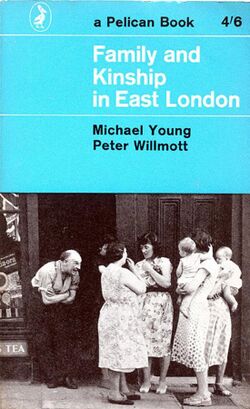Organization:Institute for Community Studies
 | |
| Formation | 1953 |
|---|---|
Parent organization | Young Foundation |
| Website | icstudies |
Early years
The Institute for Community Studies is a community-led research and evidence centre based in Bethnal Green, East London.[1] Originally founded in 1953 by Michael Young as the Institute of Community Studies, it is probably best known for the 1957 report by Young and his colleague Peter Willmott, Family and Kinship in East London, which argued for the continuing importance of community ties in the age of the welfare state. Described as a sociological "phenomenon",[2] the original Institute influenced a generation of sociologists and social historians.
The [Institute's] stated purpose was to examine the interaction of the family, the community and the social services. It promised to study the way in which ordinary people interacted with the newly expanded social service sector, and asked whether the organs of the state were in cooperation or conflict with established patterns of family support and mutual aid. — Lise Butler, "Michael Young, the Institute of Community Studies, and the Politics of Kinship", Twentieth Century British History, 2015.
Other key publications from that period include:
- The Family Life of Old People: An inquiry in East London (Peter Townsend, 1957).
- Widows and their Families (Peter Marris, 1958).
- Family and Class in a London Suburb (Peter Willmott and Michael Young, 1960).
- Family and Social Change in an African City: A study of rehousing in Lagos (Peter Marris, 1961).
- Education and the Working Class (Brian Jackson, Dennis Marsden, 1962).
- Living with Mental Illness: A study in East London (Enid Mills, 1962).
- The Evolution of a Community: A Study of Dagenham after forty years (Peter Willmott, 1963).
- Human Relations and Hospital Care (Ann Cartwright, 1964).
- Innovation and Research in Education (Michael Young, 1965).
- Adolescent Boys of East London (Peter Willmott, 1966).
- Working Class Community (Brian Jackson, 1968).
- The Symmetrical Family: A study of work and leisure in the London Region (Michael Young and Peter Willmott, 1973).
The original Institute was also the main vehicle through which Young created over 60 organisations including the Open University and the Consumers' Association (aka Which?). In 2005, the Institute of Community Studies merged with the Mutual Aid Centre and was renamed The Young Foundation in honour of Lord Young. The current chief executive of the Young Foundation is Helen Goulden and the Institute is led by Associate Director, Richard Harries.
A fresh start
The Institute was re-launched in 2019 with support from the Power to Change Trust, Friends Provident Foundation and a large private donation, with a remit to promote positive social, economic and environmental outcomes by better understanding how government and philanthropic interventions affect – and are affected by – the individuals, families and businesses that make up our local communities.[3]
The Institute for Community Studies describes itself as "a new kind of research institute, with people and communities at its heart". It places particular emphasis on the role of communities themselves in the research process, both in determining the research questions to be answered and through the use of so-called peer researchers (also known as community-based participatory researchers) to collect evidence. In its first major publication,[4] based on a coordinated series of national surveys and regional focus groups across the United Kingdom, the Institute identified seven priority areas for further research.
| Priority | Descriptive extract from Safety in Numbers? | |
| 1. | Safety | "reflects people's anxieties and feelings of insecurity, or fears for others, as much as ... personal lived experience of crime" |
| 2. | Public services | "related to the impact of cuts [and] whether those in power truly understand the impact of [their] decisions" |
| 3. | Local economy | "decline of the high street and [other] visible signs that stoke anxiety about the decline of the local community ... and how it can be reversed" |
| 4. | Social cohesion | "to be part of a community where people get on with each other, and respect each other and the place they live" |
| 5. | Community building | "an evident and vocal yearning for a sense of community ... now being powerfully reimagined through the [Covid-19] crisis" |
| 6. | Roads, transport and infrastructure | "cries of 'why are there so many potholes?' and 'why is there no (free) parking?' echoed from all four corners of the land" |
| 7. | Planning and the green belt | "the need to balance demand for new housing, the provision of affordable housing, and protection of green space" |
Notes
- ↑ Lise Butler (2015). "Michael Young, the Institute of Community Studies, and the Politics of Kinship.". Twentieth Century British History 26 (2): 203–224. doi:10.1093/tcbh/hwu063. PMID 26411065. https://academic.oup.com/tcbh/article/26/2/203/1675919.
- ↑ Jennifer Platt (1971). Social Research in Bethnal Green: An evaluation of the work of the Institute of Community Studies.. ISBN 978-1-349-00690-8. https://books.google.com/books?id=H1NdDwAAQBAJ&q=Institute+of+Community+Studies&pg=PP8.
- ↑ "Introducing the Institute for Community Studies". https://icstudies.org.uk/about-us/introducing-institute-community-studies.
- ↑ Emily Morrison; Franca Roeschert; Jana Tauschinski; Victoria Boelman (2020). Safety in Numbers? A research agenda with communities, for communities (Report). https://icstudies.org.uk/our-approach/safety-numbers.
 |


